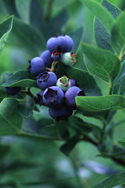 |
Blueberry
Vaccinium angustifolium, V. corymbosum, V. ashei
Family: Ericaceae
|
Return to herb list |

Photo © Steven Foster
Introduction
Blueberries are the small bluish fruits of various scrubby and bushy plants of the genus Vaccinium1 and are native to eastern North America.2 The highbush blueberry (Vaccinium corymbosum) produces large, firm blueberries and is the most widely cultivated. The lowbush (wild) blueberry (V. angustifolium), commercially important to North America, survives as far North as the Arctic Circle.2 The rabbiteye blueberry (V. ashei) is native to the southeastern US and is cultivated commercially from Tennessee and Virginia to as far south as central Florida and as far west as Arkansas and Texas.3 History and Cultural Significance
The American Indians held the wild blueberry in very high esteem, due to the fact that the blossom end of each blueberry forms a five-pointed star.4 It was believed that the Great Spirit sent these star berries to relieve the hunger of children during a famine. Native Americans also made a strong aromatic tea from the root of the blueberry plant to be used as a relaxant during childbirth. Native Americans used blueberries to make fruit pemmican, pies, pudding and upside-down cakes.5 Early settlers in America used blueberry both as a food product and as a traditional medicine.4 The blueberry is mainly used as an ingredient in pies, jams, jellies, and muffins. Various commercial products are produced with blueberries including juice, puree and concentrate. Modern Research
Blueberries were ranked second (wild blueberries) and fourth (cultivated blueberries) overall in tests to identify the most antioxidant rich fruits and vegetables when compared to more than 100 other fresh fruits and vegetables.6 Antioxidants help neutralize harmful by-products of metabolism called "free radicals" that can lead to cancer and other age related diseases. Anthocyanin is the pigment that makes the blueberries blue and is responsible for this major health benefit.7 In an Agriculture Research Service and University of Denver study, neuroscientists discovered that feeding blueberry extract to laboratory rats slowed age-related loss in their mental capacity, a finding that has important implications for humans.8 Future Outlook
Blueberries are becoming more popular as new research discloses the health and nutrient benefits. Asia, in particular, has a strong market for fresh blueberries, but other products, including dried blueberries, are also experiencing good sales.9 Demand is expected to remain steady or grow slightly in Japan, with more potential for growth in all of East Asia due to the Westernization of diets.9 Blueberries have fewer pest problems than most other fruits, but require very particular kinds of soil and moisture conditions. The fruit does not have a very long shelf life and are easily damaged in transit.2 Therefore, fresh berries may always be relatively expensive. Fortunately, blueberry plants are very productive and the fruit freezes well so they are available for commercial food production.2 References
1 Davidson A. The Oxford Companion to Food. New York: Oxford University Press; 1999. 2 Williamson J, Lyrene P. Blueberries: Varieties for Florida. University of Florida. Available at: http://edis.ifas.ufl.edu/HS215. Accessed January 26, 2005. 3 Vaccinium ashei. Floridata website. Available at http://www.floridata.com/ref/V/vac_ashe.cfm. Accessed January 25, 2006. 4 Moerman D. Native American Ethnobotany. Portland, OR: Timber Press; 1998. 5 History. Highbush blueberry. U.S. Highbush Blueberry Council 2002. Available at: http://www.blueberry.org/blueberries.htm#History. Accessed January 26, 2005. 6 New “Best Antioxidants” List. Better Nutrition. October 2004. Available at: http://www.betternutrition.com/document_display.cfm?document_id=398&keyword=blueberry&summary=1&startsum=1. Accessed January 26, 2005. 7 Blueberry. Food Museum website. Available at: http://www.foodmuseum.com/blueberry.html. Accessed August 25, 2006. 8 Joseph J. Berry Good for the Brain. USDA. April 1997. Available at: http://www.ars.usda.gov/is/np/fnrb/fnrb497.htm#berry. Accessed January 26, 2005. 9 Lee D. US Blueberries Producers Eye Opportunities in Asia. Fruit, March/April 2000. Available at: http://www.sunnyridge.com/aboutus/us_blueberry_producers_eye_oppor.htm. Accessed January 26, 2005.
|